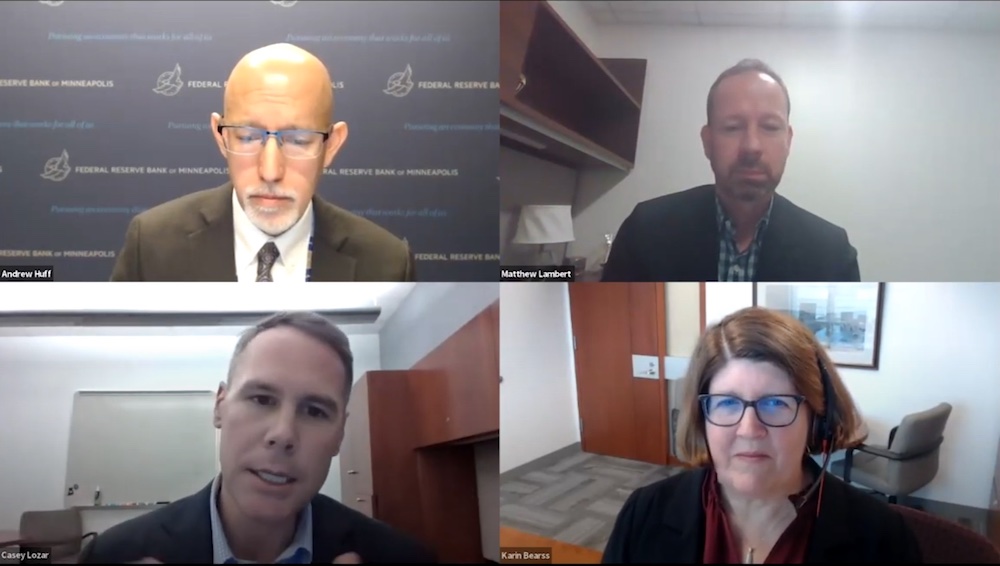
- Details
- By Chez Oxendine
- Finance
Revised regulations to a law meant to assess and support banks in meeting the credit needs of the communities they serve could increase support for Native businesses, communities, and individuals.
That’s according to an analysis shared Tuesday afternoon during a webinar hosted by the Center for Indian Country Development (CICD) at the Federal Reserve Bank of Minneapolis.
With an arc toward low- and moderate-income communities, the Community Reinvestment Act of 1977 (CRA) requires financial institutions doing business in these areas to keep records of their efforts to support the populations they serve. Those records are later used as criteria during regular examinations by the Federal Reserve System, the Federal Deposit Insurance Corporation, and Office of the Comptroller of the Currency.
The rule revision, whose final text was issued in late October after a years-long reworking, introduces zones called Native Land Areas along with a suite of regulations meant to encourage support for Native communities within these areas. These areas designate particular communities, such as lands held in trust or restricted fee lands, reservations, and Alaska Native villages, as places where banks can record CRA-approved investments, such as community centers, parks, and housing.
The designation, as well as improved accounting for banks’ support of community-driven efforts such as Native Community Development Financial Institutions (CDFIs), could be “transformative” for Indian Country, per speakers at Tuesday’s webinar.
CICD Director Casey Lozar, an enrolled member of the Confederated Salish and Kootenai Tribes, said the rule revision raised the bar for what is possible through CRA-regulated activities in Indian Country.
“The sky is the limit,” Lozar said during a webinar panel. “As we think about Indian Country, there’s an incredible amount of opportunity here, so it’s exciting to see how agile the rule will be in meeting the unique needs in those communities.”
Andrew Huff, a senior policy analyst and legal advisor at CICD, said the rule revision would impact Native economies on both the public and private levels, given the way CRA works. The act assesses banks based on their size, levying appraisals of their retail lending performance for products such as mortgages and auto loans, as well as other retail banking services, community development financing and other community-focused services such as literacy classes or partnerships with local organizations.
The rule helps address a chronic issue in Indian Country: a lack of access to capital for tribal government projects or Native individuals looking to start a business. That exacerbates existing economic troubles on reservation and off-reservation lands, where the poverty rate stands at around 35% nationally, with some areas climbing to the 50% mark.
Many Native Americans lack access to basic banking services. Among American Indian or Alaska Native households, 6.9% were unbanked in 2021, down from 16.3% in 2019, according to an FDIC report.
The combination of poverty and a lack of existing banking relationships has depressed everything from credit card limits to taxation dollars that end up choking tribal budgets desperate for revenue in support of community programs. The situation has also driven up the cost of home loans for the average Native homebuyer.
“There remains a substantial gap in the economic conditions that we see today in Native Land Areas, and the economic conditions in much of the rest of the country,” Huff said. “We hope these new rules will help close that gap.”
Under the revised CRA regulations concerning Native Land Areas, banks are now encouraged to help support community revitalization or stabilization activities, essential community facilities and infrastructure, disaster preparedness and weather-resiliency activities. That could mean anything from building a community center to retrofitting homes with energy-efficient insulation or solar panels. It could also include broadband projects to improve distance learning and telehealth.
In addition to Native Land Areas, banks are encouraged to submit activities for appraisal such as work with Native CDFIs, which have become a major financial driver in Indian Country since their advent, Huff said.
Karin Bearss, vice president of the Federal Reserve Bank of Minneapolis, called the CRA update “exciting” because it accommodates modern-day needs in communities. She pointed to the Native Land Areas as an especially promising new avenue for encouraging bank participation in Indian Country; however, Bearss cautioned that banks would need to step up and educate themselves.
“I think it’s really going to open up a lot of opportunities in Native Land Areas,” Bearrs said. “But it’s also going to be critically important for banks to really understand the changes that are going to allow them to invest in areas they maybe wouldn’t have historically invested in under the [previous] rule.”
It’s ultimately beneficial for banks to learn the new rules because working in Native Land Areas or with other approved Native partners will expand their options for CRA-approved activities, according to Matthew Lambert, senior supervisory analyst for the Board of Governors of the Federal Reserve System.
“One of the things we’ve tried to make clear in this final rule is that there are a myriad of ways to [meet CRA requirements,]” Lambert said. “As long as banks are serving their entire communities, we’re happy.”
The webinar, which is available online via YouTube, was held in partnership between CICD and a number of Native organizations, including the Affiliated Tribes of Northwest Indians, the Indian Gaming Association, the Native American Finance Officers Association (NAFO), the National Center for American Indian Enterprise Development, the National Congress of American Indians, the Native CDFI Network, and the United South and Eastern Tribe Sovereignty Protection Fund.
